Chrome tanning impacts the environment mainly through the use of toxic chromium chemicals, especially hexavalent chromium, which can contaminate water, soil, and ecosystems if not managed properly. Effluents from tanneries often pollute rivers and lakes, harming aquatic life. Soil contamination can make land unsuitable for farming. To reduce these risks, industries are adopting greener alternatives and better waste management practices. If you want to understand how these changes can make a difference, there’s more to explore.
Key Takeaways
- Chrome tanning uses toxic chromium compounds, especially hexavalent chromium (Cr(VI)), which are highly persistent and harmful to the environment.
- Effluents from chrome tanning contain chromium salts and chemicals that contaminate water bodies, affecting aquatic ecosystems.
- Soil contaminated with chromium from waste disposal impairs microbial activity and reduces land suitability for agriculture.
- Workers face health risks like skin irritation, respiratory problems, and long-term organ effects due to chromium exposure.
- Environmental regulations and sustainable practices, including wastewater recycling and natural tanning methods, are essential to mitigate pollution.
The Chrome Tanning Process Explained

The chrome tanning process transforms raw animal hides into durable leather by using chemicals, primarily chromium salts. During this process, tanning machinery is employed to soak hides in chromium solutions, which stabilize the collagen fibers. Once tanned, leather often undergoes leather dyeing to achieve desired colors, enhancing its appearance and value. The machinery facilitates uniform absorption of chemicals, ensuring consistent results. This step is essential for producing high-quality leather with improved durability and resistance to elements. Throughout, the process is highly mechanized to increase efficiency and control. Proper chemical management practices and waste management are crucial to minimizing environmental harm. Additionally, advancements in environmentally friendly tanning methods aim to reduce the ecological footprint of leather production. Proper waste disposal and recycling efforts are increasingly integrated into manufacturing workflows to mitigate pollution. Implementing sustainable practices in the chrome tanning industry can significantly reduce its environmental impact. Overall, the chrome tanning process combines chemical treatment and advanced machinery to convert raw hides into finished leather ready for various applications.
Chemical Composition and Toxicity of Chrome Agents
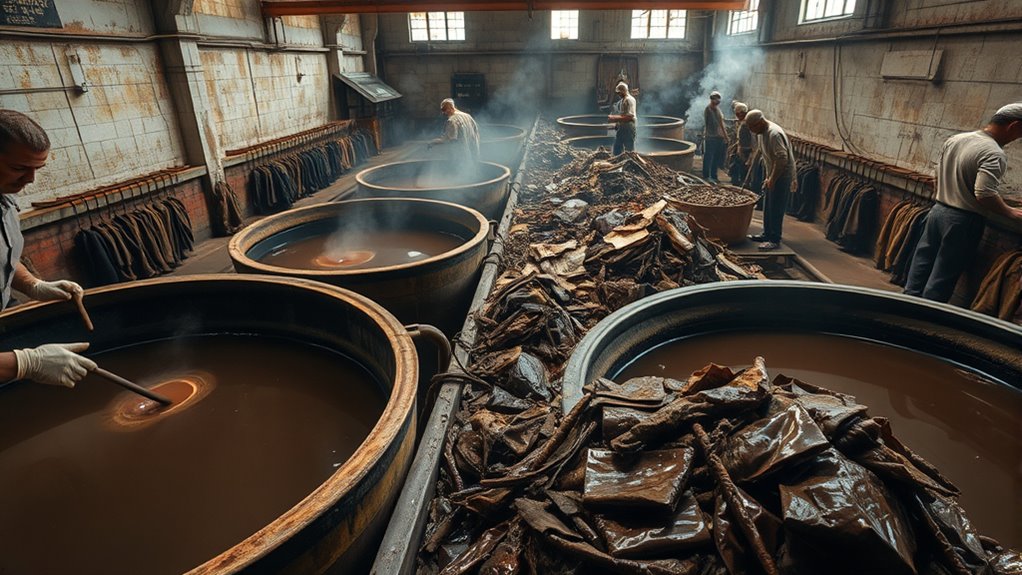
Understanding the chemical makeup of chrome agents is essential because their toxicity varies with chromium forms. You should be aware that hexavalent chromium is highly toxic and more environmentally persistent than trivalent chromium. Recognizing these differences helps you assess the health risks associated with exposure and the potential environmental impact. Additionally, implementing ethical hacking practices can aid in developing safer chemical handling protocols to minimize environmental contamination. Being informed about chemical safety standards is crucial for ensuring proper regulation and disposal practices. Moreover, ongoing research into environmentally friendly alternatives can contribute to reducing the ecological footprint of chrome tanning processes. Awareness of regulatory frameworks can further improve compliance and safety measures in the industry. Understanding the chemical properties of different chrome agents can help identify safer and more sustainable options for leather production.
Chromium Speciation and Toxicity
Chromium exists mainly in two forms: trivalent chromium (Cr(III)) and hexavalent chromium (Cr(VI)), each with distinct chemical properties and health implications. Understanding chromium speciation is key to *evaluating* toxicity levels, as Cr(III) is generally stable and less harmful, while Cr(VI) is highly toxic and carcinogenic. Cr(III) is essential in small amounts for human health but can be toxic at high concentrations. Conversely, Cr(VI) easily penetrates cells and causes oxidative damage, leading to serious health risks. In leather production, most chromium used is Cr(III), but improper handling or environmental conditions can convert it to Cr(VI). Recognizing these differences helps in *determining* the potential hazards associated with chrome agents and *ensuring* better safety practices during tanning processes. Additionally, understanding the chemical behavior of chromium compounds can aid in developing safer tanning methods and environmental controls.
Environmental Persistence of Chrome
How long do chrome agents persist in the environment, and what determines their chemical stability? Chrome compounds, especially chromium(III) and chromium(VI), can be highly persistent due to their chemical stability. The environmental persistence of chrome is influenced by factors like pH, temperature, and the presence of organic matter, which affect their biodegradation challenges. Chromium(VI) is more soluble and mobile, making it harder to break down and more likely to remain in soils and water over time. Chromium(III), while more stable, can still persist if conditions prevent its conversion or reduction. Environmental conditions play a crucial role in the longevity of these compounds, impacting their potential toxicity. The chemical composition of chrome agents contributes to their environmental persistence, posing long-term risks if not properly managed. Additionally, the chemical stability of chrome compounds plays a key role in their environmental longevity and potential toxicity. Factors such as redox potential significantly influence whether chromium exists in more mobile or stable forms in the environment. Moreover, understanding the biodegradation processes of these compounds is essential for developing effective mitigation strategies.
Health Risks of Exposure
Because of their chemical composition, chrome agents pose significant health risks when you’re exposed to them, especially through skin contact, inhalation, or ingestion. During occupational exposure, workers handling chrome compounds risk developing skin irritation, dermatitis, or more severe ulcers from direct contact. Inhalation of chrome dust or fumes can cause respiratory issues, including asthma or long-term lung damage. Ingesting contaminated substances may lead to internal toxicity, affecting organs like the liver and kidneys. Chromium VI compounds are particularly hazardous due to their high toxicity and carcinogenic potential. Protecting yourself through proper safety measures, such as gloves, masks, and adequate ventilation, is essential to minimize these health risks. Awareness of the chemical toxicity of chrome agents helps prevent dangerous occupational exposure.
Water Pollution From Tanning Effluents
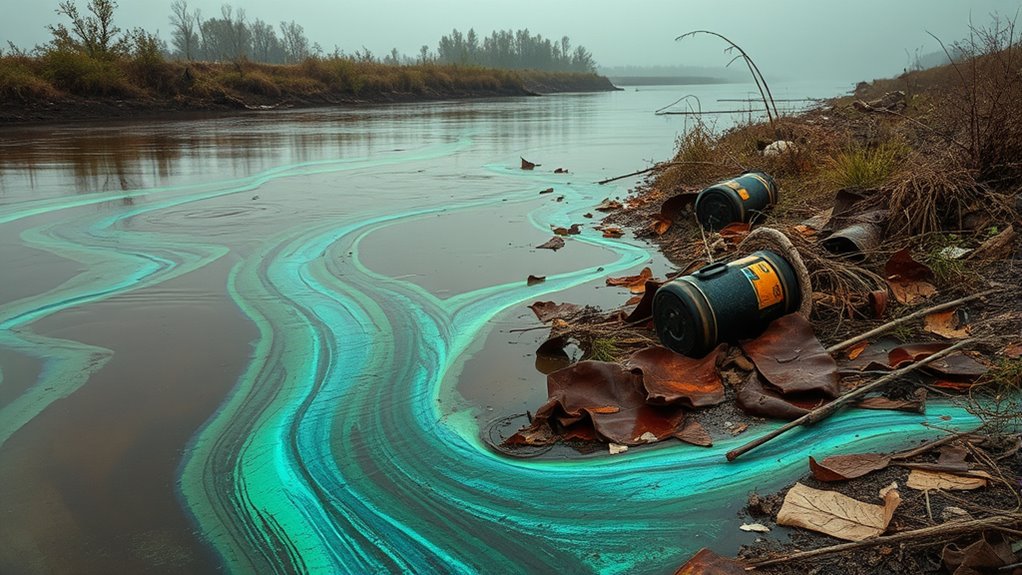
Water pollution from tanning effluents poses a significant environmental challenge, as the wastewater generated during chrome tanning contains toxic chemicals that can contaminate nearby water bodies. During leather dyeing, harmful substances like chromium salts and other chemicals are often released if not properly treated. Tanning machinery used in the process can leak or produce runoff that carries these pollutants into rivers and lakes. This contamination threatens aquatic life and poses health risks to communities relying on these water sources. Proper wastewater treatment is essential to remove hazardous chemicals before discharge. Without it, toxic effluents continue to harm ecosystems and compromise water quality. Implementing effective waste management practices is crucial for reducing the release of harmful substances into the environment. Additionally, advanced treatment technologies can help to further minimize pollution from tannery effluents. Incorporating sustainable practices into leather production can significantly reduce the environmental footprint of tanning processes. Addressing these pollution issues requires stricter regulation of tannery operations and improved management of leather dyeing and machinery to reduce environmental impact. Additionally, implementing holistic approaches to health and wellness can support community resilience and environmental awareness regarding sustainable practices. Employing innovative sound design techniques in environmental monitoring can enhance the detection and analysis of pollutants, leading to better regulation and remediation strategies.
Soil Contamination and Land Degradation

The chrome tanning process often leads to soil contamination and land degradation when waste materials and chemicals are improperly disposed of or left exposed. These hazardous substances can seep into the soil, disrupting soil health and reducing its fertility. As toxic chrome compounds accumulate, they hinder microbial activity essential for maintaining healthy soil ecosystems. This disruption can also affect soil microbial diversity, which is vital for nutrient cycling and overall soil vitality. This contamination also impacts surrounding land use, making areas unsuitable for agriculture or plant growth. Over time, the land becomes degraded, losing its capacity to support vegetation and wildlife. If waste is not managed properly, the damage can be extensive, leading to long-term environmental issues. Protecting soil health requires proper waste handling and disposal practices to prevent contamination and preserve land use potential.
Impact on Aquatic Ecosystems
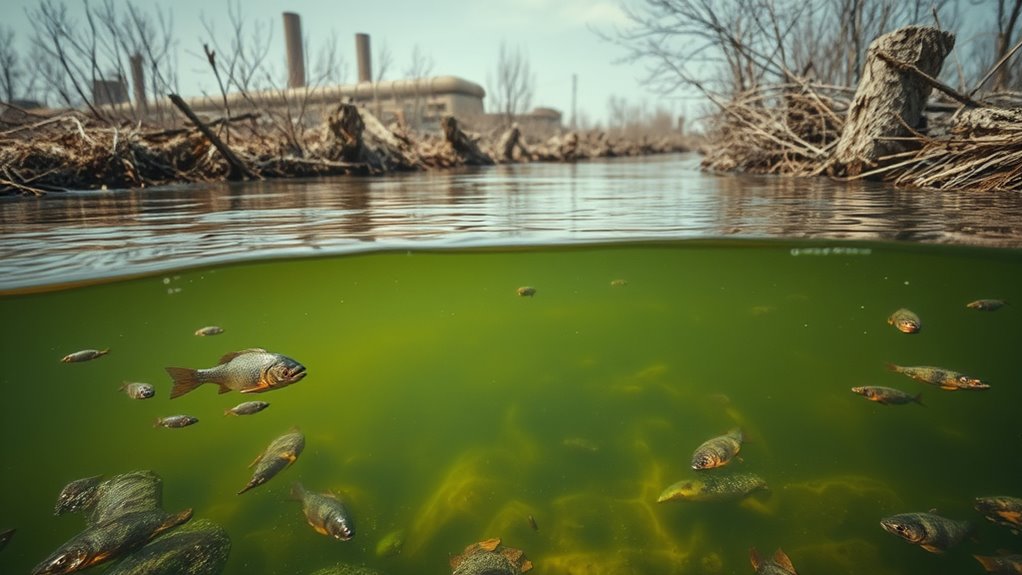
How does chrome tanning affect aquatic ecosystems? The process releases chromium compounds that increase aquatic toxicity, harming fish and invertebrates. These toxins can disrupt reproductive cycles and reduce biodiversity. Pollution control measures help limit these impacts, but improper waste management still poses risks. Additionally, the drivetrain components involved in processing can contribute to environmental contamination if not properly managed. Implementing environmental mitigation strategies is essential to minimize these negative effects on aquatic life. Furthermore, understanding the chemical properties of chromium compounds can aid in developing better treatment methods to reduce their environmental footprint.
Human Health Risks Associated With Chrome Tanning
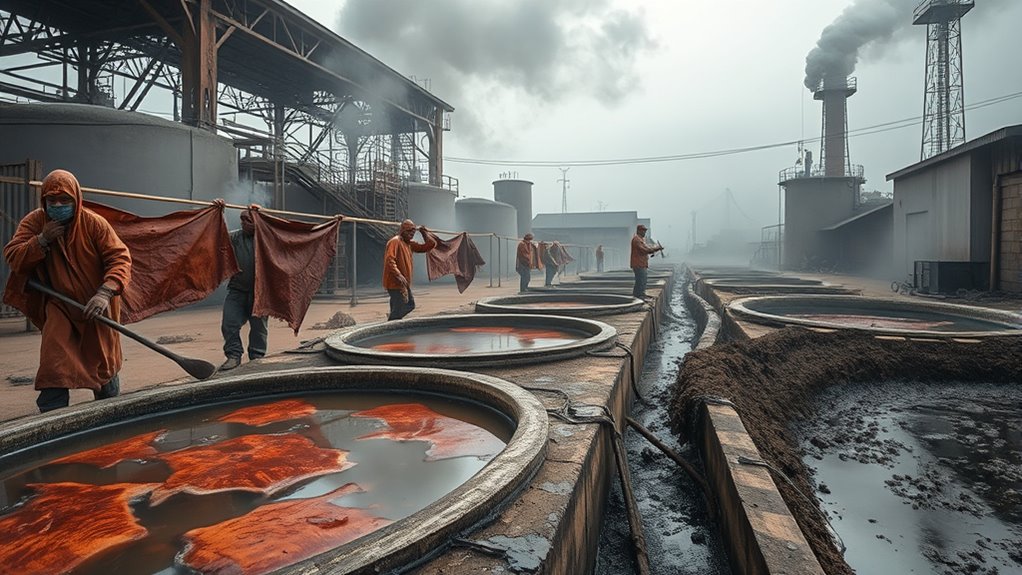
Chrome tanning poses significant health risks to workers and nearby communities because exposure to chromium compounds can lead to serious medical conditions. Occupational exposure during tanning processes puts workers at risk of skin sensitization, which can cause allergic reactions and dermatitis. Prolonged contact with chromium salts increases the chance of developing skin allergies, making workers vulnerable to chronic dermatitis. Inhalation of dust or fumes containing chromium compounds can also impact respiratory health, potentially causing asthma or other lung issues. Nearby residents may face health concerns from contaminated air or water sources. It is crucial to recognize that repeated exposure heightens the risk of long-term health problems. Protecting workers through safety measures and reducing environmental contamination can considerably lower these health risks associated with chrome tanning.
Regulatory Frameworks and Industry Standards
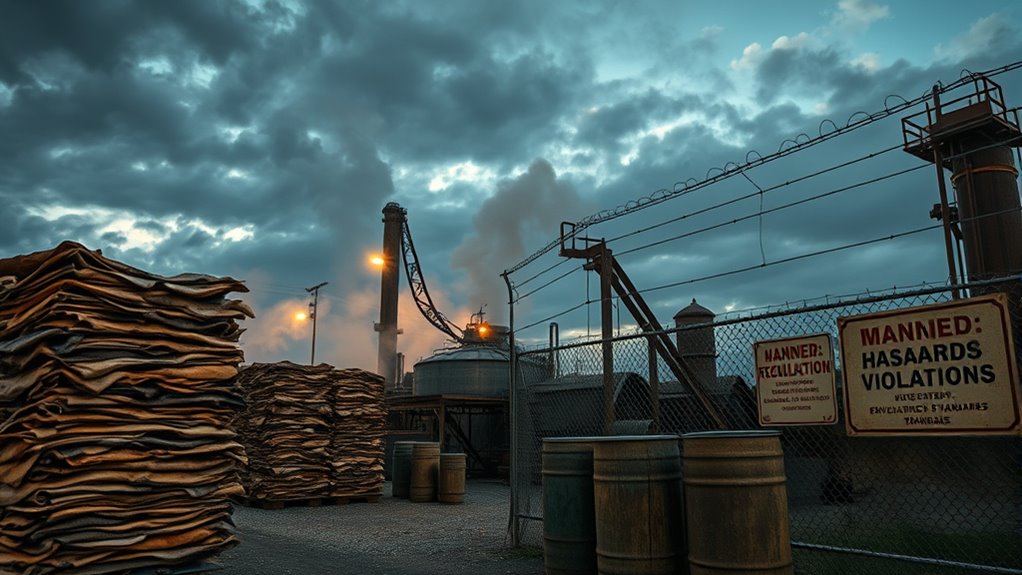
You should understand how international environmental regulations set limits on chrome use and waste disposal to protect ecosystems. Industry certification programs also play a key role in ensuring tanning facilities meet safety and environmental standards. Together, these frameworks guide the industry toward more sustainable practices and accountability.
International Environmental Regulations
Have you ever wondered how international regulations shape the environmental practices of the chrome tanning industry? These regulations influence how companies balance cultural conservation and traditional practices with environmental protection. International bodies, like the World Trade Organization and environmental treaties, set standards that encourage sustainable operations and reduce pollution. They push tanneries to adopt cleaner technologies and manage waste responsibly, respecting local customs and traditional methods. By enforcing limits on hazardous chemicals and promoting eco-friendly processes, these regulations help preserve ecosystems and communities affected by tanning activities. They also foster industry-wide accountability, ensuring that businesses meet global environmental expectations without sacrificing cultural heritage. Ultimately, international regulations serve as a critical framework guiding tanneries toward more sustainable and responsible practices worldwide.
Industry Certification Programs
Industry certification programs play a vital role in establishing clear standards and accountability within the chrome tanning industry. These programs promote transparency through eco labeling, helping consumers identify environmentally responsible products. Certification ensures tanneries meet strict environmental criteria, reducing harmful waste and chemical use. When you choose leather with recognized industry certification, you support sustainable practices and protect ecosystems. The table below highlights the emotional impact of certification:
| Confidence | Responsibility | Hope |
|---|---|---|
| Trust in eco-labels | A cleaner planet | A better future |
| Fair labor | Reduced pollution | Preservation for generations |
| Transparency | Ethical sourcing | Empowered consumers |
| Accountability | Industry progress | Hope for change |
| Pride in sustainability | Protecting nature | Commitment to eco-friendly leather |
Sustainable Alternatives to Chrome Tanning

What alternatives exist to reduce the environmental footprint of chrome tanning? You can explore eco-friendly dyes that minimize chemical use and pollution, helping to lower environmental impact. Additionally, switching to tanning processes that utilize renewable resources, such as plant-based extracts or mineral-based agents, offers a sustainable option. These alternatives often require less water and energy, reducing waste and emissions. Using natural materials also decreases the reliance on toxic chemicals found in traditional chrome tanning. Incorporating eco-friendly dyes and renewable resources not only benefits the environment but can also appeal to eco-conscious consumers. While these options may involve some adjustments in production, they contribute appreciably to making leather manufacturing more sustainable and less damaging to ecosystems.
Innovations and Technologies for Greener Tanning Methods

Advancements in plant-based tanning and synthetic alternatives are transforming the industry toward more sustainable practices. You can also benefit from wastewater recycling technologies that reduce environmental pollution. Exploring these innovations helps you adopt greener tanning methods effectively.
Plant-Based Tanning Advances
Recent innovations in plant-based tanning are paving the way for more sustainable and eco-friendly leather production. This method uses plant extracts and natural agents instead of harmful chemicals, reducing environmental impact. Advances in natural dyeing enhance the eco-friendliness by avoiding synthetic dyes, making the entire process greener. You can explore these developments through the following:
| Innovation | Impact |
|---|---|
| Tannin-rich plant extracts | Replace chrome salts, lower toxicity |
| Natural dyeing techniques | Reduce chemical runoff, improve biodegradability |
These plant-based tanning methods offer a promising alternative that aligns with eco-conscious practices. By embracing natural tannins and dyes, you minimize pollution and promote sustainability in leather manufacturing.
Synthetic Alternatives Development
Building on the progress made with plant-based tanning, researchers are now developing synthetic alternatives that aim to further reduce environmental harm. These innovations focus on creating tanning agents using biodegradable dyes and eco-friendly chemicals that minimize toxic residues. By replacing traditional chrome salts, these synthetic methods lower the risk of water pollution and soil contamination. Advances include the use of bio-based polymers and chemical formulations designed to break down naturally after use. This not only reduces the ecological footprint but also offers safer working conditions in tanneries. As technology evolves, the integration of these greener chemicals promises to make leather production more sustainable, aligning industry practices with environmental goals. You can play a role by supporting and adopting these innovative, eco-conscious tanning solutions.
Wastewater Recycling Technologies
Innovative wastewater recycling technologies are transforming the leather tanning industry by substantially reducing water consumption and minimizing environmental pollution. Modern treatment plants utilize advanced filtration systems to treat effluents efficiently. These systems remove harmful chemicals, heavy metals, and organic pollutants before recycling water back into the process. By implementing these technologies, tanneries can reuse water multiple times, lowering their freshwater intake and decreasing the load on local water sources. Additionally, sophisticated filtration systems improve water quality, ensuring that waste is effectively treated and environmental discharge standards are met. This not only benefits the environment but also reduces operational costs for tanneries. Embracing these innovations helps create greener tanning methods, making the industry more sustainable and less damaging to ecosystems.
Steps Toward Reducing Environmental Footprint
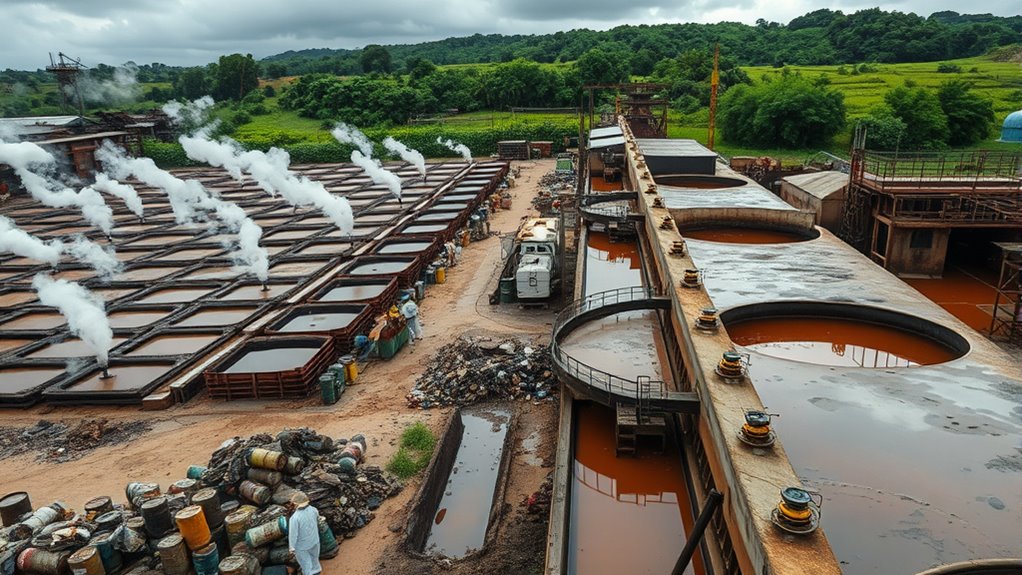
To reduce the environmental footprint of chrome tanning, industry stakeholders are adopting a range of sustainable practices. Implementing stronger environmental policies encourages factories to minimize hazardous waste and cut emissions. Consumer awareness is also crucial; informed customers demand eco-friendly products, pushing brands to adopt greener methods.
Here’s a snapshot of sustainable steps:
| Action | Impact | Key Focus |
|---|---|---|
| Using eco-friendly chemicals | Reduces toxic waste | Environmental policies |
| Recycling chrome waste | Lowers resource consumption | Consumer awareness |
| Investing in cleaner technologies | Decreases pollution | Industry innovation |
Frequently Asked Questions
How Does Chrome Tanning Affect Local Biodiversity?
You might wonder how chrome tanning impacts local biodiversity. When waste containing chrome chemicals leaks into soil, it causes soil contamination, harming plants and microorganisms. Additionally, if these chemicals reach nearby water bodies, they increase aquatic toxicity, threatening fish and aquatic life. Such pollution disrupts ecosystems, reduces biodiversity, and can lead to long-term environmental damage, making it essential to manage waste properly to protect the local environment.
What Are the Long-Term Environmental Consequences of Chrome Waste?
You should be concerned about the long-term effects of chrome waste, as it can lead to chromium leaching into soil and water, causing persistent soil contamination. This contamination can harm plants, animals, and even human health over time. Left unchecked, the toxic residues linger, accumulate, and spread, threatening ecosystems and communities. Recognizing these consequences urges you to advocate for safer, eco-friendly alternatives and stricter waste management practices.
Are There Economic Incentives for Adopting Eco-Friendly Tanning Methods?
You’ll find that adopting eco-friendly tanning methods offers significant economic incentives. The cost benefits include lower waste management expenses and improved efficiency. Additionally, regulatory incentives often reward businesses for reducing environmental impact, helping you save money and meet legal standards. Embracing sustainable practices not only benefits the environment but also enhances your brand reputation, potentially attracting more customers and increasing profits in the long run.
How Do Developing Countries Manage Chrome Pollution Regulations?
You see developing countries balancing economic growth with environmental protection. While regulatory enforcement exists, it often falls short due to limited resources or corruption. Pollution control measures are implemented, but enforcement can be inconsistent, allowing chrome pollution to persist. This contrast highlights the challenge: managing chrome pollution regulations demands stronger oversight and investments, which many developing nations struggle with, risking environmental health and public safety despite their intentions.
What Role Does Consumer Awareness Play in Reducing Chrome Tanning Impacts?
You play a vital role in reducing the impacts of chrome tanning through consumer education and making sustainable choices. When you’re aware of how your purchases affect the environment, you’re more likely to choose leather products made with eco-friendly processes. Your informed decisions can influence brands to adopt better practices, encouraging industry-wide change. By staying educated and mindful, you help promote sustainable options and reduce harmful chrome pollution in leather production.
Conclusion
As you walk through a forest, imagine the invisible toxins seeping into the soil and water, quietly harming delicate ecosystems. Choosing sustainable tanning methods is like clearing a path through this shadowy landscape, allowing nature to breathe and thrive again. By embracing greener technologies, you help transform this dark, polluted terrain into a vibrant, flourishing habitat—proof that your choices can turn the tide, restoring the beauty and health of our planet’s precious environment.









